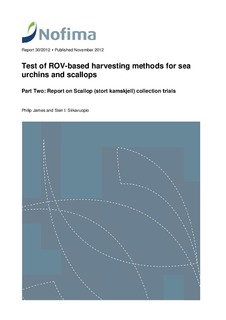| dc.contributor.author | James, Philip | |
| dc.contributor.author | Siikavuopio, Sten Ivar | |
| dc.date.accessioned | 2018-07-06T08:46:07Z | |
| dc.date.available | 2018-07-06T08:46:07Z | |
| dc.date.created | 2014-09-15T10:58:05Z | |
| dc.date.issued | 2012 | |
| dc.identifier.isbn | 978-82-8296-017-5 | |
| dc.identifier.uri | http://hdl.handle.net/11250/2504626 | |
| dc.description.abstract | A series of trials were conducted to test the efficacy of the SeabedHarvester ROV for collecting scallops. The ROV had a specifically designed collector installed for the scallop trials. The trials were undertaken in December 2011 (Frøya), April 2012 (Frøya) and September 2012 (Helgeland). Catch rates improved significantly over the course of the trials as a result of the modifications made to the collector between trials, and the increasing confidence of the ROV pilots. The maximum catch rate recorded in Trial 3 was 46.9 kg/hr. This is approximately half the catch rates required to make the use of the ROV economically viable according to industry estimates. The authors believe the catch rates recorded in the trials are very conservative compared to what the optimal catch rates would be. Further trials would be required to define the maximum catch rates the ROV is capable of collecting. Although the catch rate needs to be improved the ROV does offer a number of advantages over traditional dive operations for scallops. These include: • The ROV only requires a single operator (compared to 4 divers) reducing the logistics of organizing a dive crew • There are none of the health and safety issues/restrictions associated with diving • The ROV is not depth or time restricted as are divers and can fish scallops at depths from 1-100m depth for as long as it takes to fill the catch tray. The ROV is as environmentally friendly as dive operations and there were no obvious differences in shell quality in scallops collected by ROV compared to scallops that were handpicked by divers. The authors made the following recommendations at the conclusion of the trials: • The trials have shown that it is possible to catch scallops using the ROV • The modifications made to the scallop collecting system throughout the trials have made significant improvements in catch efficiency. However, further refinement is needed in order to increase catching efficacy • In order to reach the target catch of 800-1000 kg/day the catch rates recorded by the ROV would need to be doubled • Further testing is recommended to familiarize a pilot with the use of the ROV and to establish whether it is economically viable to utilize an ROV for scallop collection. | |
| dc.description.abstract | Rapport/Report 30/2012 Norsk sammendrag | |
| dc.description.abstract | Test of ROV-based harvesting methods for sea urchins and scallops. Part two: Report on scallop (stort kamskjell) collection trials | |
| dc.language.iso | eng | |
| dc.publisher | Nofima AS | |
| dc.relation.ispartof | Nofima rapportserie | |
| dc.relation.ispartofseries | Nofima rapportserie | |
| dc.relation.uri | https://nofimaas.sharepoint.com/sites/public/_layouts/15/guestaccess.aspx?guestaccesstoken=a%2f4TO6GNcdXxZZb%2bAZsf%2bz0SBHuDc3S2xxV6DWEtcp0%3d&docid=0fba7b9a581354b39b56aa91c788c68dc | |
| dc.title | Test of ROV-based harvesting methods for sea urchins and scallops. Part two: Report on scallop (stort kamskjell) collection trials | |
| dc.title.alternative | Rapport/Report 30/2012 Norsk sammendrag | |
| dc.title.alternative | Test of ROV-based harvesting methods for sea urchins and scallops. Part two: Report on scallop (stort kamskjell) collection trials | |
| dc.type | Research report | |
| dc.description.version | publishedVersion | |
| dc.source.pagenumber | 27 | |
| dc.source.issue | 30/2012 | |
| dc.identifier.cristin | 1154413 | |
| dc.relation.project | Fiskeri- og havbruksnæringens forskningsfond: 900714 | |
| dc.relation.project | Nofima AS: 21069 | |
| cristin.unitcode | 7543,1,5,0 | |
| cristin.unitname | Produksjonsbiologi | |
| cristin.ispublished | true | |
| cristin.fulltext | original | |
